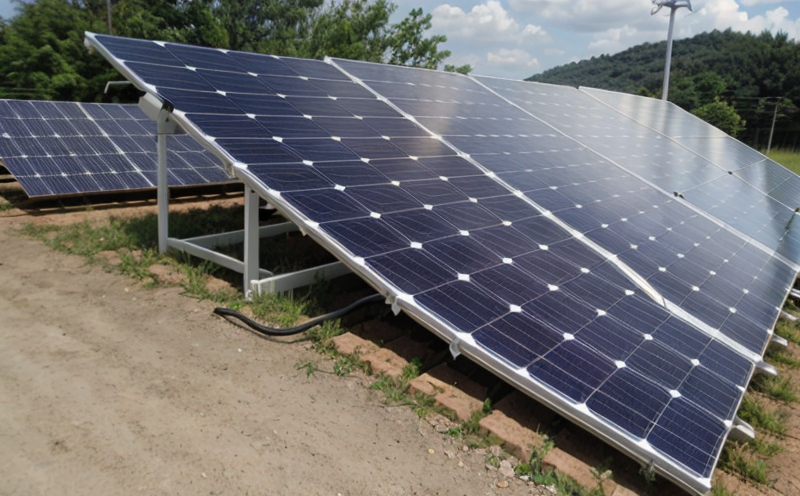IEC 61730-2 Cut Susceptibility Testing
The IEC 61730-2 standard addresses the cut susceptibility of photovoltaic (PV) modules, a critical aspect in ensuring the safety and reliability of solar panels. This test evaluates how PV modules respond to cuts or punctures that may occur during transport, installation, or operation. The test is particularly important for ensuring that any electrical arcs generated by such cuts do not lead to dangerous situations or fires.
The IEC 61730-2 standard covers two main parts: part 1 focuses on mechanical integrity and thermal stability tests, while part 2 deals with cut susceptibility. The latter is a critical test for PV modules that operate under high voltage conditions. According to the standard, this test involves subjecting the module to a controlled electrical arc initiated by a sharp blade that cuts through one or more conductors of the module.
The testing process typically requires careful specimen preparation and precise instrumentation. Prior to the test, the PV module is cleaned thoroughly and visually inspected for any defects. After cleaning, the module undergoes a series of preliminary tests such as electrical resistance checks and visual inspections for cracks or damages that might affect the cut susceptibility results.
The actual test involves placing the prepared module on a specialized fixture within an electrically insulated chamber. The blade is then brought down onto the conductors to create an electrical arc, which simulates real-world conditions of potential damage. The duration and intensity of the arc are carefully controlled according to IEC 61730-2 specifications.
The test results are evaluated based on predefined criteria that include the absence of smoke, flames, or other visible signs of fire. The module’s behavior during the arc is also recorded for detailed analysis. Compliance with this standard ensures that PV modules can withstand accidental cuts without posing a risk to personnel and infrastructure.
Understanding the implications of IEC 61730-2 testing is crucial for manufacturers, installers, and safety engineers working in renewable energy sectors. By ensuring compliance with these standards, stakeholders contribute significantly to enhancing public safety and the reliability of solar power systems.
Industry Applications
The IEC 61730-2 cut susceptibility test is widely used across various applications within the renewable energy sector. It is particularly relevant for manufacturers, installers, and operators of photovoltaic solar panels.
| Application | Description |
|---|---|
| Solar Module Manufacturing | Ensures that PV modules can withstand accidental cuts without sparking or creating a fire hazard. |
| Rooftop and Ground-Mounted Solar Systems | Aids in the safe installation of solar panels on rooftops and large ground-mounted structures, reducing risks during transport and setup. |
- Solar farm development: Ensures that all components meet international safety standards before deployment.
- Residential rooftop installations: Protects homeowners by ensuring the highest level of safety for their solar systems.
- Commercial facilities: Guarantees compliance with local and international regulations, enhancing credibility and trustworthiness.
Quality and Reliability Assurance
The IEC 61730-2 cut susceptibility test is an integral part of quality assurance programs in the photovoltaic industry. This test helps manufacturers ensure that their products meet stringent safety standards, thereby enhancing overall reliability.
- Compliance with International Standards: Ensures compliance with IEC 61730-2, a globally recognized standard for PV modules.
- Enhanced Safety: Reduces the risk of fire and electrical hazards associated with accidental cuts or punctures in solar panels.
| Acceptance Criteria | Description |
|---|---|
| No visible smoke | The module should not produce any signs of combustion during the test. |
| No flames | The module must not ignite and sustain a flame during testing. |
| Minimal damage to the module | The module should retain its structural integrity after the cut susceptibility test. |
The results of this test are crucial for manufacturers as they provide valuable insights into the durability and safety features of their products. By meeting these standards, companies can build a strong reputation in the market and ensure long-term customer satisfaction.
International Acceptance and Recognition
The IEC 61730-2 cut susceptibility test is recognized worldwide for its stringent criteria and comprehensive approach to ensuring the safety of photovoltaic modules. This international acceptance is crucial as it allows manufacturers, suppliers, and installers to comply with global regulatory requirements.
Many countries have adopted this standard due to its rigorous testing procedures and emphasis on safety. For instance, Europe follows EN 61730-2, which is harmonized with IEC standards. In the United States, the National Electrical Code (NEC) references IEC 61730 as a recognized standard for PV module performance.
By adhering to these internationally accepted standards, stakeholders can ensure that their products are safe and reliable not only in their home markets but also when exporting to various countries. This global recognition enhances the reputation of compliant companies and simplifies regulatory compliance across different jurisdictions.





